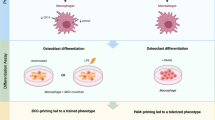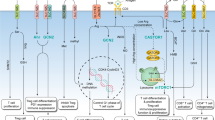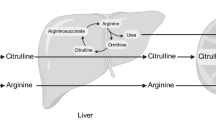Abstract
Protein malnutrition (PM) is an important public health problem that affects resistance to infection by impairing a number of physiological processes. PM induces structural changes in the lymphoid organs that affect the roles of the immune and inflammatory responses in a crucial way. The activation of different transcription factors, including signal transducer and activator of transcription (STAT) family members, leads to the production of different cytokines, which are mediators essential to mounting adequate immune and inflammatory responses. In this study, malnourished animals presented anemia, leukopenia, and a severe reduction in spleen cellularity, with reduced numbers of most cell populations, as well as increased percentages of CD3+ and CD4+ cells. The proliferation rates were reduced, and cells were increasingly observed in the G0/G1 cell cycle phase; further, IL-2 production was reduced, while IL-10 production was increased. In spleen cells from malnourished animals, STAT-3 protein expression was increased, with a concomitant reduction in STAT-1 expression. Knowing that STAT-1 and STAT-3 are key transcription factors in both immunity and inflammatory pathways, these results infer, at least in part, a mechanistic pathway that affects the manner or intensity of the immune response in malnourished individuals, increasing susceptibility to infection.







Similar content being viewed by others
References
Calder, P.C. 2013. Feeding the immune system. Proceedings of the Nutrition Society 72: 299–309.
Brundtland, G.H. 2000. Nutrition and infection: Malnutrition and mortality in public health. Nutrition Reviews 58: S1–S4.
Fock, R.A., M.A. Vinolo, V. de Moura Sá Rocha, L.C. de Sá Rocha, and P. Borelli. 2007. Protein-energy malnutrition decreases the expression of TLR-4/MD-2 and CD14 receptors in peritoneal macrophages and reduces the synthesis of TNF-alpha in response to lipopolysaccharide (LPS) in mice. Cytokine 40: 105–114.
Ortiz, R., L. Cortés, E. Cortés, and H. Medina. 2009. Malnutrition alters the rates of apoptosis in splenocytes and thymocyte subpopulations of rats. Clinical and Experimental Immunology 155: 96–106.
Lim, S.L., K.C. Ong, Y.H. Chan, W.C. Loke, M. Ferguson, and L. Daniels. 2012. Malnutrition and its impact on cost of hospitalization, length of stay, readmission and 3-year mortality. Clinical Nutrition 31: 345–350.
Chandra, R.K. 2003. Nutrition and immunology: From the clinic to cellular biology and back again. Journal of Nutrition 133: 336S–340S.
Savino, W. 2002. The thymus gland is a target in malnutrition. European Journal of Clinical Nutrition 56: S46–S49.
Olejniczak, K., and A. Kasprzak. 2008. Biological properties of interleukin 2 and its role in pathogenesis of selected diseases—a review. Medical Science Monitor 14: RA179–RA189.
Nathan, C., and M. Sporn. 1991. Cytokines in context. Journal of Cell Biology 113: 981–986.
Akira, S. 1999. Functional roles of STAT family proteins: Lessons from knockout mice. Stem Cells 17: 138–146.
Durbin, J.E., R. Hackenmiller, M.C. Simon, and D.E. Levy. 1996. Targeted disruption of the mouse Stat1 gene results in compromised innate immunity to viral disease. Cell 84: 443–450.
Levy, D.E., and C.K. Lee. 2002. What does Stat3 do? Journal of Clinical Investigation 109: 1143–1148.
Ho, H.H., and L.B. Ivashkiv. 2006. Role of STAT3 in type I interferon responses. Negative regulation of STAT1-dependent inflammatory gene activation. Journal of Biological Chemistry 281: 14111–14118.
Monk, J.M., T.A. Steevels, L.M. Hillyer, and B. Woodward. 2011. Constitutive, but not challenge-induced, interleukin-10 production is robust in acute pre-pubescent protein and energy deficits: New support for the tolerance hypothesis of malnutrition-associated immune depression based on cytokine production in vivo. International Journal of Environmental Research and Public Health 8: 117–135.
Fock, R.A., M.A. Vinolo, A.R. Crisma, K. Nakajima, M.M. Rogero, and P. Borelli. 2008. Protein-energy malnutrition modifies the production of interleukin-10 in response to lipopolysaccharide (LPS) in a murine model. Journal of Nutritional Science and Vitaminology 54: 371–377.
Reeves, P.G., F.H. Nielsen, and G.C. Fahey Jr. 1993. AIN-93 purified diets for laboratory rodents: Final report of the American Institute of Nutrition ad hoc writing committee on the reformulation of the AIN-76A rodent diet. Journal of Nutrition 123: 1939–1951.
Ward, P.G. 1963. A micro-Kjeldahl procedure for field use. Journal of Medical Laboratory Technology 20: 191–195.
Gornall, A.G., C.J. Bardawill, and M.M. David. 1949. Determination of serum proteins by means of the biuret reactions. Journal of Biological Chemistry 177: 51.
Doumas, B.T., W.A. Watson, and H.G. Biggs. 1971. Albumin standards and the measurement of serum albumin with bromocresol green. Clinica Chimica Acta 31: 87–96.
Harris, R.I., and J. Kohn. 1974. The pre-albumin fraction: A useful parameter in the interpretation of routine protein electrophoresis. Journal of Clinical Pathology 27: 986–989.
Livak, K.J., and T.D. Schmittgen. 2001. Analysis of relative gene expression data using real-time quantitative PCR and the 2(-Delta Delta C(T)) method. Methods 25: 402–408.
Okin, D., and R. Medzhitov. 2012. Evolution of inflammatory diseases. Current Biology 22: R733–R740.
Powanda, M.C., and W.R. Beisel. 2003. Metabolic effects of infection on protein and energy status. Journal of Nutrition 133: 322S–327S.
Fock, R.A., M.A. Vinolo, S.L. Blatt, and P. Borelli. 2012. Impairment of the hematological response and interleukin-1β production in protein-energy malnourished mice after endotoxemia with lipopolysaccharide. Brazilian Journal of Medical and Biological Research 45: 1163–1171.
Israëls, T., M.D. van de Wetering, P. Hesseling, N. van Geloven, H.N. Caron, and E.M. Molyneux. 2009. Malnutrition and neutropenia in children treated for Burkitt lymphoma in Malawi. Pediatric Blood & Cancer 53: 47–52.
Catchatourian, R., G. Eckerling, and W. Fried. 1980. Effect of short-term protein deprivation on hemopoietic functions of healthy volunteers. Blood 55: 625–628.
Fock, R.A., S.L. Blatt, B. Beutler, J. Pereira, M. Tsujita, F.E. de Barros, and P. Borelli. 2010. Study of lymphocyte subpopulations in bone marrow in a model of protein-energy malnutrition. Nutrition 26: 1021–1028.
Cortés-Barberena, E., H. González-Márquez, J.L. Gómez-Olivares, and R. Ortiz-Muñiz. 2008. Effects of moderate and severe malnutrition in rats on splenic T lymphocyte subsets and activation assessed by flow cytometry. Clinical and Experimental Immunology 152: 585–592.
Fló, J., F. Elías, R. Benedetti, and E. Massouh. 1996. Reversible effects on B and T cells of the gut-associated lymphoid tissues in rats malnourished during suckling: Impaired induction of the immune response to intra-Peyer patches immunization with cholera toxin. Clinical Immunology and Immunopathology 80: 147–154.
Keusch, G.T. 2003. The history of nutrition: Malnutrition, infection and immunity. Journal of Nutrition 133: 336S–340S.
Chandra, R.K. 1997. Nutrition and the immune system: An introduction. American Journal of Clinical Nutrition 66: 460S–463S.
Amaral, J.F., D.A. Foschetti, F.A. Assis, J.S. Menezes, N.M. Vaz, and A.M. Faria. 2006. Immunoglobulin production is impaired in protein-deprived mice and can be restored by dietary protein supplementation. Brazilian Journal of Medical and Biological Research 39: 1581–1586.
Lee, W.H., and B.D. Woodward. 1996. The CD4/CD8 ratio in the blood does not reflect the response of this index in secondary lymphoid organs of weanling mice in models of protein-energy malnutrition known to depress thymus-dependent immunity. Journal of Nutrition 126: 849–859.
Rodríguez, L., C. González, L. Flores, L. Jiménez-Zamudio, J. Graniel, and R. Ortiz. 2005. Assessment by flow cytometry of cytokine production in malnourished children. Clinical and Diagnostic Laboratory Immunology 12: 502–507.
González-Martínez, H., L. Rodríguez, O. Nájera, D. Cruz, A. Miliar, A. Domínguez, F. Sánchez, J. Graniel, and M.C. González-Torres. 2008. Expression of cytokine mRNA in lymphocytes of malnourished children. Journal of Clinical Immunology 28: 593–599.
Rodríguez, L., E. Cervantes, and R. Ortiz. 2011. Malnutrition and gastrointestinal and respiratory infections in children: A public health problem. International Journal of Environmental Research and Public Health 8: 1174–1205.
Murray, P.J. 2005. The primary mechanism of the IL-10-regulated antiinflammatory response is to selectively inhibit transcription. Proceedings of the National Academy of Sciences of the United States of America 102: 8686–8691.
Kim, B.H., A.R. Shenoy, P. Kumar, R. Das, S. Tiwari, and J.D. MacMicking. 2011. A family of IFN-γ-inducible 65-kD GTPases protects against bacterial infection. Science 332: 717–721.
Najjar, I., and R. Fagard. 2010. STAT1 and pathogens, not a friendly relationship. Biochimie 92: 425–444.
Lang, R., D. Patel, J.J. Morris, R.L. Rutschman, and P.J. Murray. 2002. Shaping gene expression in activated and resting primary macrophages by IL-10. Journal of Immunology 169: 2253–2263.
Gimeno, R., C.K. Lee, C. Schindler, and D.E. Levy. 2005. Stat1 and Stat2 but not Stat3 arbitrate contradictory growth signals elicited by alpha/beta interferon in T lymphocytes. Molecular and Cellular Biology 25: 5456–5465.
Staples, K.J., T. Smallie, L.M. Williams, A. Foey, B. Burke, B.M. Foxwell, and L. Ziegler-Heitbrock. 2007. IL-10 induces IL-10 in primary human monocyte-derived macrophages via the transcription factor Stat3. Journal of Immunology 178: 4779–4785.
Malek, T.R. 2002. T helper cells, IL-2 and the generation of cytotoxic T-cell responses. Trends in Immunology 23: 465–467.
Stephanou, A., and D.S. Latchman. 2005. Opposing actions of STAT-1 and STAT-3. Growth Factors 23: 177–182.
Acknowledgments
This investigation was supported by grants from the Fundação de Amparo a Pesquisa do Estado de São Paulo (FAPESP) and the Research Network on Bioactive Molecules from Arthropod Vectors (NAP-MOBIARVE, University of Sao Paulo).
Author information
Authors and Affiliations
Corresponding author
Rights and permissions
About this article
Cite this article
Mello, A.S., de Oliveira, D.C., Bizzarro, B. et al. Protein Malnutrition Alters Spleen Cell Proliferation and IL-2 and IL-10 Production by Affecting the STAT-1 and STAT-3 Balance. Inflammation 37, 2125–2138 (2014). https://doi.org/10.1007/s10753-014-9947-5
Published:
Issue Date:
DOI: https://doi.org/10.1007/s10753-014-9947-5




